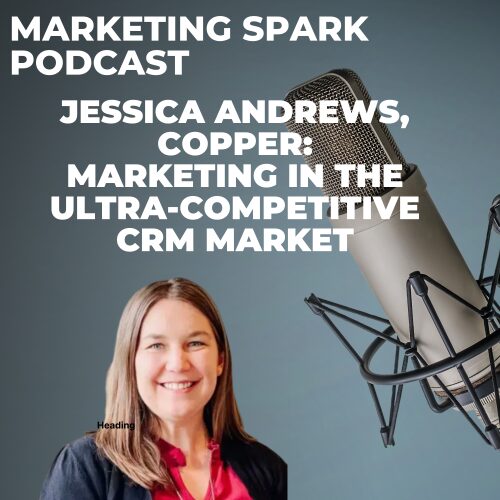In a crowded market where dozens, if not hundreds, of brands are battling for attention, strong brand positioning can be the key to standing out and driving success.
This is particularly true in industries like Customer Relationship Management (CRM), where differentiation is essential to thrive amid fierce competition.
This post explores how Copper, a small CRM company known for innovative and bold marketing, has repositioned itself to stand out amid giants like HubSpot and Salesforce.
We delve into a conversation with Jessica Andrews, Copper’s VP of Marketing, who shares insights on how her team successfully navigated the challenges of redefining their marketing strategy.
Identifying a Niche Market
Copper started by zeroing in on specific industries that could significantly impact—agencies, consulting, and financial services. These industries value relationships tremendously, and their sales cycles are rarely linear. This unique market insight helped Copper build a foundation to focus its brand positioning efforts.
Jessica said this focused positioning wasn’t an overnight decision but an iterative process that evolved over the years. By leveraging its designation as the only CRM recommended for Google Workspace, Copper aimed to capture any Google Workspace-using company.
However, it soon became clear that larger companies needed more from a CRM, leading Copper to focus on areas where they had the most loyal customers.
Many SaaS companies, including Copper, have recently experienced volatile economic conditions. These challenges necessitated reevaluating marketing strategies to better connect with target segments. Jessica Andrews discussed how her team had to adapt storytelling to reflect these economic realities without drastically changing their core messaging.
Copper’s shift in brand positioning was informed by detailed customer feedback and usage data. The company used product tours and email series to understand customer needs and adoption rates better. By focusing on the ‘end-to-end customer relationship management’ model, the brand messaging was aligned more closely with what customers sought rather than trying to be everything for everyone.
Leveraging LinkedIn for Thought Leadership
Copper has stood out through its use of LinkedIn for thought leadership. Andrews emphasizes the importance of crafting authentic posts that resonate with the audience. She often listens on calls or meetings and writes LinkedIn posts on behalf of Copper’s leadership to ensure their voices are heard.
Another exciting shift in Copper’s marketing strategy is experimenting with platforms like YouTube and Reddit.
While these platforms may not have initially delivered direct conversions, post-trial surveys revealed that many users discovered Copper through these channels. This insight led to increased investment in higher-funnel content to educate potential customers long before they enter the buying cycle.
A critical aspect of successful brand repositioning is ensuring all departments, including product and marketing teams, are on the same page. Andrews notes that the collaborative efforts within Copper have been instrumental in aligning the product with the new brand messaging. It takes a CEO who understands the importance of this alignment to drive such a coordinated approach.
Measuring Success
Metrics are paramount for understanding the success of any repositioning effort. Copper measures customer adoption rates for new product features and tracks these against changes in messaging across different touchpoints. This data-driven approach helps quantify the effectiveness of their branding efforts.
Achieving successful brand repositioning requires cross-departmental alignment and collaboration. Marketers must ensure that everyone, from product teams to the C-suite, is pulling in the same direction.
The story of Copper’s brand repositioning is a testament to the power of strategic focus and adaptive marketing.
By focusing on specific market needs, leveraging new platforms, and ensuring team-wide alignment, Copper has differentiated itself in a highly competitive CRM landscape.
For B2B marketers, Copper’s journey offers valuable lessons about authenticity, strategic adaptability, and cross-department collaboration.
For more insight into Copper’s marketing, listen to the podcast.
The podcast was sponsored by LeadFeeder, know who’s coming to your Website, convert more leads and get a free trial at Leadfeeder.com/try



